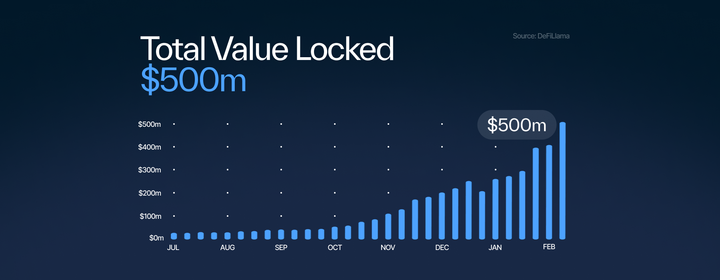Sui Becomes the Top Platform for Defi Growth
Sui's fitness as a DeFi platform was proved through three month growth in TVL and volume.

The Sui network saw incredible growth in decentralized finance (DeFi) activity over the past three months, with Total Value Locked (TVL) rising 341 percent and volume rising 229 percent. This growth represents an important milestone for the network and demonstrates the utility Sui provides to third party developers in its DeFi ecosystem and their ability to support millions of users for alternative financial services.
Sui serves DeFi protocols through its parallel processing and low gas fees. With the former, users can expect their transactions to achieve finality quickly, concluding trades as close to current market conditions as possible. And low gas fees means that a minimal amount of a user's token supply pays for transactions.
These technology advantages led to over 20 builders choosing Sui for their DeFi protocols, with projects including decentralized exchanges (DEXes), lending, and liquid staking. The proliferation of DeFi protocols on Sui, occurring within six months of Mainnet launch, gives users many options to engage with DeFi.
TVL growth
Relevant metrics, such as TVL and DeFi activity volume, indicate Sui is hitting its stride as a DeFi platform. DeFi LLama, an authoritative source for DeFi activity, shows three month TVL going from $13.08 million to $57.69 million from July 17 to October 17 this year, a 341 percent increase. The TVL metric assesses the total value of digital assets that are locked or staked on a blockchain.
DeFi activity volume shows even stronger growth. Seven day averages for daily DeFi activity on July 16 and October 16 come in at $1.77 million and $5.84 million, respectively. Those numbers show volume growth of 229 percent.
Sui’s DeFi growth, especially on TVL and volume, has a variety of causes, including:
- Ecosystem support for DeFi builders
- Institutional engagement
- Individual engagement
Most importantly, however, is Sui’s product market fit, showing that Sui’s unique architecture, programmability, and performance are well attuned for a burgeoning DeFi ecosystem.
In particular, the Sui Foundation supports builders, including those in DeFi, through a robust grant program. These grants go to projects that demonstrate value to the Sui ecosystem and help grow the network. The program takes into account the builders' experience and likelihood of success. This support is one reason behind TVL growth, as DeFi builders with adequate funding leverage Sui's technology to create opportunities for users and institutions to engage in DeFi activity.
DeFi protocols
Whether supported by grants or not, DeFi builders recognize Sui's potential. The roster of projects available gives users a wide variety of venues, each with unique characteristics, to swap, stake, and engage in other DeFi activities.
DeepBook, Sui's first native liquidity layer, boosts DeFi capability on Sui by providing a built-in order book supporting trades. DeepBook was deployed as a public good, so the only overhead in using it are the gas fees required for any transaction on the network. Deepbook matches token buyers and sellers, ensuring Sui's core DeFi capability. Builders are free to create DeFi apps leveraging DeepBook, adding their own features and capabilities to attract users.
DEXes
The 10 DEXes currently hosted on Sui let users trade a variety of tokens and place them in liquidity pools. The DEXes maintain conversion rates to swap one token for another. Liquidity pools typically earn a percentage interest rate for use who contribute, derived from transaction fees.
The top DEXes in terms of TVL on Sui include Cetus, KriyaDex, Aftermath Finance, Turbos Finance, and BlueFin. Each of these protocols offer DeFi services ranging from token swaps to bridging to liquidity pools. Some DEXes, such as Aftermath Finance and Turbos Finance, include smart routing, an algorithm that finds the best path to minimize slippage when users execute transactions. Others offer their own unique features. Cetus, for example, offers what it calls concentrated liquidity, letting users target a specific trading rate, making for more efficient liquidity pools.
Lending
Protocols currently showing the most TVL on Sui for lending services include Navi Protocol, Scallop Lend, and OmniBTC. These protocols typically let users lend tokens and borrow tokens, serving as an intermediary between users with liquidity and those that need liquidity. Although these protocols show high TVL in their lending activities, they may also offer trading, bridging, and liquidity pools.
Liquid staking
Sui introduced liquid staking earlier this year, letting people leverage their staked tokens for DeFi activities. In a liquid staking hackathon held by the Sui Foundation, three projects appeared among the six winners. Aftermath Finance came up with afSUI, which provides a fully on-chain, decentralized, and liquid extension of Sui's native staking mechanism. Haedal Protocol offered a liquid staking protocol allowing anyone to stake their SUI tokens to contribute to governance and decentralization of the Sui blockchain. And Volo won for its decentralized liquid staking platform dedicated to offering a fully decentralized liquid staking and supporting the Sui ecosystem's growth with utility and yield strategies.
DeFi strength
As TVL and DeFi activities increase on Sui, more opportunities will open for users and builders alike. Users will find larger liquidity pools and more options for token trades. Builders can attract new users as they innovate on-chain DeFi activities.
However, DeFi's long term promise goes beyond trading tokens. Services in retail finance such as banking and deposit accounts, payments, credit, and insurance could someday leverage Sui's built-in security, stability, and efficiency to reduce costs and give users a better experience. Institutions could turn to Sui for financial applications such as asset tokenization, trading, foreign exchange, and a wealth of other use cases.



